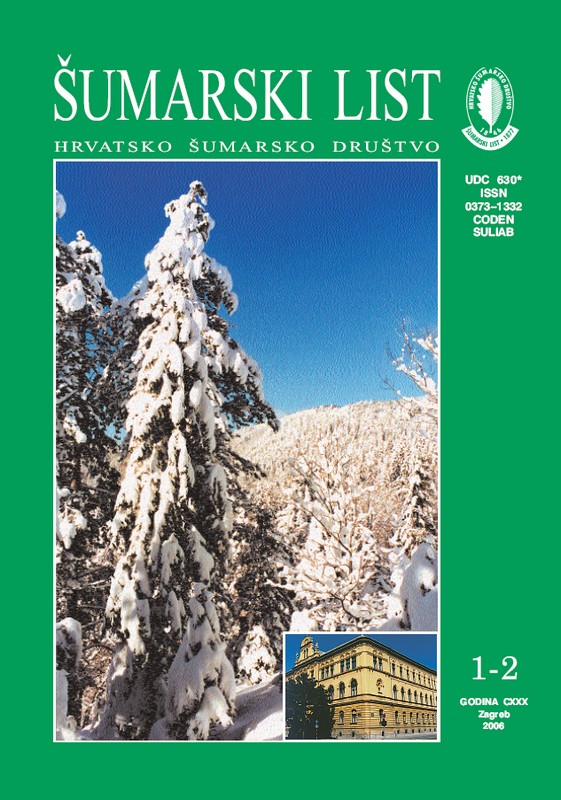
broj: 1-2/2006
pdf (19,7 MB) |
|
||||||||||||||
| IZVORNI ZNANSTVENI ČLANCI | ||
| Josip Franjić, Željko Škvorc, Andraž Čarni | UDK 630* 181.1 + 188 (001) | |
| Distribution of Crataegus nigra Waldst. et Kit. in Croatia and its Importance for Forest Edge Vegetation Formation pdf HR EN | 3 | |
| Juraj Zelić | UDK 630* 242 + 651 (001) | |
| The Influence of Intensively Thinning on Valuably Shares Of Assortiments Of Meturing Beech Assotiation pdf HR EN | 9 | |
| Sandra Golubić | UDK 630* 233 + 114.5 (001) | |
| Possibilities of waste disposal on the area of the Međimurje County in the case of the Totovec waste disposal yard pdf HR EN | 21 | |
| PREGLEDNI ČLANCI | ||
| Josip Karavla | UDK 630* 272 | |
| Dendrological characteristics of the City of Zagreb Green Horseshoe Suggestion for the regeneration of its eastern part pdf HR EN | 31 | |
| Dalibor Ballian | UDK 630* 165 | |
| Markers and Basic Mesaures of Genetic Variability Significant in Molecular Genetic Studies pdf HR EN | 41 | |
| Dario Kremer, Ksenija Karlović, Vesna Židovec | UDK 630* 164 | |
| Morphometric Research of Natural Populations of Ruscus Hypoglossum L. in Croatia pdf HR EN | 47 | |
| Summary: In order to obtain the insight in the variability of natural populations of Ruscus hypoglossum L., legally protected species, the morphometric research was done on specimens from seven natural habitats (Japlenica, Skupica, Vrhovčak, Strahinščica, Gornji Dragonožac, Kalnik and Oriovac). Stem length, the total number of phylloclades and bracts, the length and width of the phylloclades and bracts, and the internodium length were measured. The ratio between length and width of phylloclades and bracts, respectively were calculated for insight in shape of phylloclades and bracts. It was determinate that the analysed morphological characteristics were very variable. The variability coefficient for populations in total varied from 21.35 % for ratio between length and width of bracts to 56.90 % for the internodium length. UPGMA analysis with Euclidean distance has shown that the populations Oriovac and Strahinščica were the most similar (DE = 1.75). The population that differed the most from the others was the population Japlenica which is connected to the other six populations on the high level (DE = 6.94). Plants from population Japlenica had the longest stems and the biggest phylloclades and bracts. Also, the plants from the population Japlenica had the highest number of phylloclades and bracts per stem. In the other six populations, the population Kalnik distinguished itself by the most oblong phylloclades. The similar results to cluster analysis were obtained by principal component analysis. The highest contribution to the first PC axis gave the length of phylloclades, bracts, stem and internodium. The ratio between the length and width of phylloclades, the ratio between length and width of bracts, and the number of phylloclades per stem had the most contribution to the second PC axis. Key words: morphometry; PCA; Ruscus hypoglossum; UPGMA | ||


